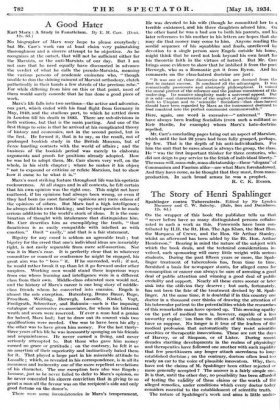The Story of Henri Spahlinger
ON the wrapper of this book the publisher tells us that " never before have so many distinguished persons collabo- rated in such a work as this. Forewords have been con- tributed by H.H. the Rt. Hon. The Aga Khan, the Most Hon. the Marquess of Crewe, and the Hon. Sir Arthur Stanley, whilst an afterword has been added by the Rt. Hon. Arthur Henderson." Bearing in mind the nature of the subject with which the book deals, and the technical considerations in- volved, such sponsoring will carry little weight with serious students. During the past fifteen years or more, the Spah- linger treatment of tuberculosis has, from time to time, furnished a basis for newspaper stunts, for alleged cures for consumption or cancer can always be sure of arresting a good deal of public attention and winning a good deal of public credulity and support. Nearly all these cures sooner or later sink into the oblivion they deserve ; but such, fortunately, has not been the fate of the treatment devised by M. Spah- linger. At the same time, it is doubtful if in this country one doctor in a thousand ever thinks of drawing the attention of his tubercular patient to the potentialities which the researches of this remarkable man have opened up. This seeming apathy on the part of medical men is, however, capable of a less unworthy explaEL' ion than the editors of this volume would have us suppose. No -longer is it true of the leaders of the medical profession that automatically they resist scientific novelties or therapeutic innovations. These are not the days of Harvey, or of Simpson, or of Lister. During recent decades startling developments in the realms of physiology and therapeutics have followed one another with such rapidity that few practitioners any longer attach sacredness to long- established doctrine.; on the contrary, doctors often lend too ready -an ear to the voice of plausible innovators. Why, then, have not the claims of M. Spahlinger been either rejected or more generally accepted ? The answer is a fairly simple one. It is that, until the other day, no possibility has been afforded of testing the validity of these claims or the worth of the alleged remedies, under conditions which every doctor today considers essential to the establishment of scientific truth.
The nature of SpahLinger's work and aims is little under- stood by the public. - When the tubercle bacillus was dis- covered by Koch in 1881, optimists felt that victory over con- sumption was near at hand. It was hoped that the pro- gressive success of Listerian principles in surgery would be paralleled in our fight with what was then at the head of the list of causes of death in this country. In many infectious diseases a single attack protects its -victim, should he survive, from subsequent liability to infection, at any rate for a term of years. Small-pox, scarlet fever, diphtheria and measles- are common examples of this. Defensive or neutralizing forces are automatically organized by the body when attacked by these diseases ; and, in favourable cases, an excess of antidote remains in the blood ready to counter a subsequent invasion. A great advance in practical medicine was made when it was realized that, by vaccination with suitable pro- vocants, such antibodies could be produced in the blood before actual infection ; and that the blood of other animals might be similarly provoked to produce an excess of antibodies, which then could be used to neutralize the toxins of disease in man, even when the native defences had been exhausted. Spahlinger has devoted his life and his resources to the dis- covery of ways whereby these methods of therapy might be applied to the prevention and curc of consumption.
In spite of the individual instances adduced in this book, however, few experienced doctors are yet convinced that Spahlinger's serum offers a cure for established tuberculosis— though, in the absence of convincing evidence, it would be absurd to deny its possible effectiveness. His preventive vaccine stands on a different footing ; and though, here also, evidence of direct human applicability is—perhaps inevitably —inadequate, the recent experiments in Norfolk and in Northern Ireland afford something more than prima fat-le evidence that the bovine vaccine has very real value as a pre- ventive of tuberculosis in cattle.
The biographic and expository parts of this volume are interesting and helpful to the understanding of Spahlinger's w ck ; but the book's propagandist value—at any rate, for those most directly concerned—is seriously lessened by the exaggerated emphasis laid on the hostility shown to M. Spahlinger by a few disgruntled medical men in his own country. No acknowledgement is made of the many sym- pathetic, though critical, leading articles that have appeared in the Lancet and the British Medical Journal ; and scant reference is made to the repeated offers of the Ministry of Health to investigate Spahlinger's claims, if only he would send a supply of vaccine and serum for the purpose. Nor do we find much about the generous gift of £30,000 made by the British Red Cross, or the other assistance offered by wealthy admirers and sympathizers. Spahlinger's work needs no such









































 Previous page
Previous page